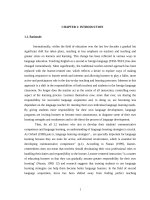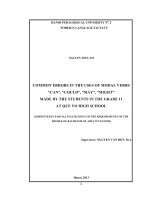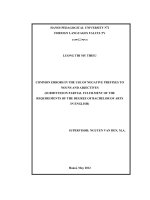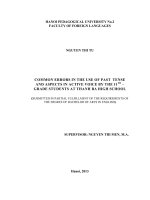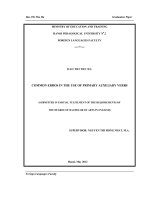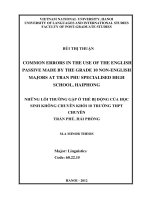Common errors with final consonants of english majored sophomores at tay do university
Bạn đang xem bản rút gọn của tài liệu. Xem và tải ngay bản đầy đủ của tài liệu tại đây (192.13 KB, 49 trang )
TABLE OF CONTENTS
Acknowledgements.............................................................................................i
Comments...........................................................................................................ii
Table of Contents................................................................................................iii
List of Abbreviations...........................................................................................vi
List of Tables.......................................................................................................vii
List of Figures.....................................................................................................viii
Abstract............................................................................................................... ix
CHAPTER 1 – INTRODUCTION..................................................................1
1.1. Rationale...........................................................................................1
1.2. The significance of the study.............................................................3
1.3. The organization of the study............................................................3
CHAPTER 2 – LITERATURE REVIEW.......................................................4
2.1. Definition of pronunciation...............................................................4
2.2. The importance of pronunciation in communication.........................5
2.2.1. The advantages of pronunciation competence..........................6
2.2.1.1. Positive impression.......................................................6
2.2.1.2. Better listening comprehension skills...........................6
2.2.1.3. Improving English speaking skills................................6
2.2.2. The disadvantages of mispronunciation...................................7
2.2.2.1. Miscommunication.......................................................7
2.2.2.2. Misunderstanding.........................................................7
1
2.2.2.3. Bad habits.....................................................................8
2.3. Final consonant sounds in English....................................................8
2.3.1. Structural features of /s/, /z/ and /iz/ ending sounds.................9
2.4. Previous studies.................................................................................10
CHAPTER 3 – RESEARCH METHODOLOGY..........................................12
3.1. Research questions............................................................................12
3.2. Research aims...................................................................................12
3.3. Hypothesis.........................................................................................12
3.4. Design...............................................................................................13
3.5. Participants........................................................................................13
3.6. Instruments........................................................................................13
3.6.1. Questionnaire...........................................................................13
3.6.2. Recording.................................................................................14
3.6.3. Interview..................................................................................14
3.7. Procedures.........................................................................................14
CHAPTER 4 – RESEARCH RESULTS.........................................................15
4.1. Results of Pronunciation error collection..........................................15
4.1.1. Questionnaire...........................................................................15
4.1.1.1. The participants’ awareness of pronunciation............15
4.1.1.2. The participants’ causes of pronunciation errors.......17
4.1.2. Recording.................................................................................21
4.1.2.1. Group 1.................................................................................21
2
4.1.2.2. Group 2.................................................................................22
4.1.3. Interview..................................................................................23
4.2. Causes of errors.................................................................................24
CHAPTER
5
–
DISCUSSION,
IMPLICATION,
LIMITATION,
SUGGESTIONS FOR THE FURTHER RESEARCH, CONCLUSION......27
5.1. Discussions........................................................................................27
5.2. Implication........................................................................................29
5.3. Limitation..........................................................................................30
5.4. Suggestions for the further research..................................................30
5.5. Conclusion........................................................................................31
REFERRENCES
APPENDICES
APPENDIX A: Questionnaire...............................................................x
APPENDIX B: Interview.......................................................................xvi
APPENDIX C: Recording.....................................................................xviii
3
LIST OF ABBREVIATIONS
L2: Second Language
IPA: International Phonetic Association
4
LIST OF TABLES
Table 1: Classification of English final consonants.............................................8
Table 2: The participants’ awareness of pronunciation........................................15
Table 3: The participants’ causes of pronunciation errors...................................17
5
LIST OF FIGURES
Figure 1: Pronunciation errors of Group 1..........................................................21
Figure 2: Pronunciation errors of Group 2..........................................................22
6
ABSTRACT
The present study aims to investigate whether or not English – majored sophomores
make mistakes the consonant /s/, /z/ and /iz/ of English words in the coda position.
The focus is on two points. The first one is to identify the most common error in the
word – final position that was employed by students at Tay Do University, and the
second one is to find the reasons which caused these errors in their pronunciation.
Fifty participants from two Bachelor of English classes at Tay Do University were
recruited for this study. A questionnaire, an interview and a recording are
instruments in the research. The results of this study demonstrate that students do
make errors with the final consonants /s/, /z/ and /iz/. After data analysis, the
researcher concluded that the omission errors which was often encountered by
learners. The study also found that the main reason led to pronunciation errors was
that Vietnamese language does not have the same sound /s/, /z/ and /iz/ in the coda.
APPENDIX A
QUESTIONNAIRE
7
Dear friends,
My name is Nguyen Hong Hanh and I am currently a senior majoring in English. I
am very grateful to you for spending your valuable time helping me. Now I am
carrying out a research entitled “Common Errors with Final Consonants of
English-Majored Sophomores at Tay Do University”. This is the questionnaire
used to collect the necessary information from you, so please take your time to
finish these below questions carefully because your answers are very important and
helpful to my research. Once again, thank you so much!
Student’s full name:................................................................................. Age: ……
Class:....................................................... Gender:
Male
Female
A. Please read the following questions and circle the appropriate answers for each
question. Give specific answers if needed.
1. How long have you studied English?........years
2. Where do you come from?
a. City
b. Countryside
3.
a.
b.
c.
d.
Which subject did you learn when you were in school?
Listening
Speaking
Reading
Writing
4.
a.
b.
c.
d.
Which subject do you like best?
Listening
Speaking
Reading
Writing
5. Have you studied pronunciation in Speaking?
a. Yes
b. No
6. What do you think about pronunciation?
8
a.
b.
c.
d.
Very important
Important
Normal
Not important
7.
a.
b.
c.
d.
e.
What do you think about your pronunciation skill?
Very good
Quiet Good
Average
Bad
Very bad
8. Do you take your time to practice pronunciation at home?
a. Yes. (continue question 8)
b. No.
9.
a.
b.
c.
d.
How much time do you have to practice pronunciation?
15 minutes
30 minutes
1 hour
More than 1 hour
B. Please read the following statements and mark () in the suitable column to
express your opinion.
Statements
Strongly
agree
(1)
1. Pronunciation is the first
importance aspect so that
learners can speak like a
native speaker.
9
Agree
(2)
No
ideas
(3)
Disagre
e
(4)
Strongly
disagree
(5)
2. Pronunciation
is
an
essential part of language.
3. Pronunciation connects with
four
language
skills
(listening, reading, writing
and speaking).
4. Pronunciation
affects
learners’
communication
competence.
5. Students need to be aware
of pronunciation so that
they are able to participate
in conversations.
6. Pronunciation is the first
thing that natives notice
when communicating.
7. The
clear pronunciation
makes sure of success in
finding a job.
8. I often make mistakes of
pronunciation, specifically
final consonants.
10
9. I feel difficult to pronounce
the ending sounds because
Vietnamese people do not
have to pronounce them.
10. I concentrate on other skills
(listening, reading, writing
and speaking) than learning
pronunciation.
11. I am not confident enough
to speak the ending sounds
out loud.
12. I am confused about the
final consonants /s/, /z/, /iz/
because I lack knowledge
of these consonants.
13. I do not have enough time
to practice pronunciation in
class.
14. I do not have many chances
of talking with the English
native speakers.
11
15. I do not have
effective
methods of practicing the
final consonants /s/, /z/, /iz/.
16. I have not got good habits
of pronouncing the final
consonants yet.
17. Sometimes I forget how to
pronounce plural words;
therefore, I cannot speak
English properly.
18. Teachers do not give their
feedback or guide to show
the
correct
way
to
pronounce.
19. Teachers pay attention to
theory more than practice.
20. The
university does not
provide good facilities to
support in learning English
pronunciation.
THANKS FOR YOUR HELP!
12
APPENDIX B
INTERVIEW QUESTIONS
Student’s full name:.......................................................................... Age: ……
Class:................................................. Gender:
Male
Female
1. Did you often make mistakes of pronouncing the final consonants? If yes,
continue question 2; if no, continue question 4.
(Bạn có thường mắc lỗi trong phát âm phụ âm cuối hay không? Nếu có, tiếp
tục với câu 2; nếu không, tiếp tục với câu 4).
..........................................................................................................................
..........................................................................................................................
2. What your errors in pronouncing the final consonants /s/, /z/, /iz/?
(substitution, omission and insertion or other errors).
(Bạn mắc những lỗi gì khi phát âm phụ âm cuối /s/, /z/, /iz/? thay thế thành
âm khác, bỏ qua không đọc hoặc thêm một âm nữa hay là những lỗi nào
khác).
..........................................................................................................................
..........................................................................................................................
..........................................................................................................................
..........................................................................................................................
3. Can you tell me some possible reasons for these errors?
(Bạn có thể kể một vài lí do cho những lỗi phát âm trên?).
..........................................................................................................................
..........................................................................................................................
..........................................................................................................................
13
..........................................................................................................................
4. What do you think about pronunciation?
(Bạn nghĩ gì về phát âm?)
..........................................................................................................................
..........................................................................................................................
..........................................................................................................................
..........................................................................................................................
5. How do you feel about your pronunciation skill? (excellent, normal or bad)?
(Bạn có cảm nghĩ gì về kĩ năng phát âm của mình?)
..........................................................................................................................
..........................................................................................................................
..........................................................................................................................
..........................................................................................................................
THANKS FOR YOUR HELP!
APPENDIX C
RECORDING
14
Today is Jessica’s first day of kindergarten. Jessica’s Mom walks with her to her
classroom. Jessica meets her teacher. His name is Mr. Parker. The school bell rings
at 8:00am. Jessica hugs and kisses her Mom to say goodbye. Jessica’s Mom says “I
love you”. Mr Parker calls out children’s name. Each child yells back “Here”. Mr
Parker requests the students to sit on the carpet. Mr Parker teaches them about
letters. Mr Parker teaches them about numbers. Mr Parker reads the students a story.
Mr Parker teaches the students a song. The lunch bell rings. Jessica’s first day of
school is over.
15
CHAPTER 1
INTRODUCTION
This chapter describes in detail (1) the rationale of the study, (2) the significance of
the study, and (3) the organization of the thesis.
1.1. Rationale
English may not be the most spoken language in the world, but it is the
official language in a large number of countries. According to Wikipedia, English
has developed over the period of more than 1,400 years and it is considered as the
official language in almost 60 countries, hence it is the third most popular native
language in the world, after Mandarin (the official language of China) and Spanish.
Besides, more and more people who have learned English as a second language
than native speakers, they are using it as a common way to communicate with each
other such as international businesses, conferences, social events and in their daily
lives even. Therefore, it is impossible to avoid being a situation that many
employers will need to hire people who can speak more than their own native
language.
From awareness of that situation, Vietnam has promoted and interested in
developing communication English competence for Vietnamese people, specifically,
English has become one of the official subjects in their state education system.
Generally, children start to learn the language as soon as they are grade 3 or earlier
because their parents may suppose that the sooner they can access with English, the
better they can reach a high level in school after. In fact, because of their increased
demands more and more, the series of free English courses online have appeared
and hundreds of English training centers have been built in Vietnam so far.
Although many Vietnamese people begin their English education very early
at schools, they cannot pronounce English properly because many teachers only pay
16
attention to study grammar more than practice. People do not speak the same
language, of course, they cannot communicate so there is a barrier between the
sound systems of the two languages. For this reason, it is not easy for those who
want to be good at pronunciation because the sound systems of the mother tongue
and L2 are different in many aspects. Ly (2007) stated that both second and foreign
language learners run into difficulties to advance in second language (L2)
pronunciation accuracy because of the differences of sound systems between their
first language and L2. Also, Bintuki (2008) argued that almost all of the L2 learners
believe that pronunciation is the main difficulty when speaking English.
The concept of final consonants do not exist in the Vietnamese sound system
like /s/, /z/, /iz/. As Nguyen (2007) states, "English, as prestigious as it is, has
extremely many final sounds that are foreign to Vietnamese speakers" (p.8).
Similarly, Ha (2005) argued that the way Vietnamese speakers pronounce the
ending sounds is completely different from English speakers. In addition, Nguyen
(as cited in Ngo, 2005; Tran, 2002) showed that although the Vietnamese language
only has six final consonants such as /p, t, k, m, n, ŋ/, they are not often produced
sounds. For example, /p/ (pháp/ lap), /t/ (cắt/ cut), /k/ (rác/ luck), /m/ (làm/ mom),
/n/ (sơn, son) and /ŋ/ (phông/ song). While English has the variety of more complex
final consonants /p, b, f, v, s, z, tʃ, dʒ, ʒ, ʃ, θ, ð,…/ and they may be articulated in
English.
The amount of research about the pronunciation problems of L2 learners is
growing so far, for both international and national studies. For instance, current
researchers analyze errors of pronunciation with some English consonants made by
English major students (Nguyen & Ha, 2015), there also find out the difficulties for
Vietnamese when producing English final consonants (Nguyen, 2007). However,
there have not had the studies that show common errors with final consonants, more
specifically, /s/, /z/, /iz/. Thus, this paper will find out whether students often make
mistakes with –s/-es ending consonants and some common errors in pronouncing
final sounds. This research desires both students and teachers to realize the
17
differences between Vietnamese and English language soon. And they must attempt
to find an effective solution for themselves to deal with the influences of the mother
tongue on their English pronunciation.
1.2. The significance of the study
After investigating common errors with final consonants, the findings of the
study are hoped that the students may reduce the mistakes of their pronunciation as
well as in their communication. And the students will be able to pronounce final
sounds /s/, /z/, /iz/ more exactly so that they will have full confidence to say it out
loud.
Besides analyzing the causes, it will also help teachers to better understand
the matter and quickly apply more practice in their classroom routine well.
Therefore, students may succeed in reaching better effects in their learning and
teachers may achieve particular goals of their education.
1.3. The organization of the study
This thesis includes five chapters consisting of (1) Introduction, (2)
Literature review, (3) Research methodology, (4) Research result, and (5)
Discussion and conclusion for further research.
Chapter 1 introduces the rationale and the significance of the research. This
section also presents the organization of the research.
Chapter 2 is the review of literature, introduces the definition and the
importance of pronunciation and some final consonants will also be discussed.
Previous studies on these issues are then included.
Chapter 3 focuses on research methodology. This chapter shows the research
question, the research aim and the hypothesis. Moreover, it also indicates the design
of the research, the instruments and participants.
Chapter 4 analyzes the result of the data from the questionnaire, the
recording and the interview. From that, the results are reckoned up from them.
Chapter 5 discusses about the discussion, the implication, the limitations and
the suggestions for further research and conclusions.
18
CHAPTER 2
LITERATURE REVIEW
This chapter describes in detail (1) the definition of pronunciation, (2) the
importance of pronunciation, (3) the final consonant sounds, and (4) the previous
studies.
2.1. Definition of pronunciation
There is much-related research suggested many definitions of pronunciation.
According to Hoang (as cited in Kelly, 2000), pronunciation is a method of
producing sounds so that the speaker can express ideas and feelings with other
people. Meanwhile, Schlippe et al. (2013) wrote that the International Phonetic
Association (IPA) uses special symbols to represent the sounds of the oral language
which is used widely and accepted agreements and they suggest pronunciations in
terms of IPA symbols. These conventions are meant to maintain languages and are
very convenient when including pronunciations for multi-languages.
Moreover, according to Çimenli (as cited in McArthur, 1992, p.810), “the act
or result of producing the sounds of speech, including articulation, intonation, and
rhythm”. In addition to many studies, Wikipedia supposed pronunciation is the way
in which a word is pronounced or the way a particular individual makes the sound
of a word in a correct pronunciation simply. By the same token, Richards and
Schmidt (2002) defined that:
The way a certain sound or sounds are produced. Unlike articulation, which
refers to the actual production of speech sounds in the mouth, pronunciation stresses
more the way sounds that are perceived by the hearer, for example: You have not
pronounced this word correctly. And it often relates the spoken word to its written
form, for example: In the word knife, the k is not pronounced. (p.429)
19
Furthermore, pronunciation has been described as the "Cinderella" area of
the language learning because pronunciation is forgetful by teachers like
"Cinderella" who is also neglected from the social life by her stepsisters in the
famous fairy tale (see Çimenli, 2015). In another research, Chavangklang (2013)
also agreed that pronunciation is awarded as one of the main subjects of L2,
students are still difficult to deal with English pronunciation although they have
studied English for many years. And Ha (2005) claimed that many foreigners
commented that only a small number of Vietnamese people had the ability to speak
English intelligibly in communication.
2.2. The importance of pronunciation
Like some other languages, English pronunciation training is the first
important aspect that any learners have to master in order to speak like a native
speaker. According to Centerman and Krausz (2011), the goal of teaching the
second language (L2) has to prepare a comfortable English-speaking environment
for students so that they can achieve their English language development. Students
need to be aware of pronunciation in order to gain a high level of competence in
English as well as they are able to participate in conversations and get more
information in the L2 language. Pronunciation is an essential part of language in a
direct connection with four language skills (listening, reading, writing and
speaking) because the main purpose of language is considered as communication in
the target language (Çimenli, 2015).
As Ly (as cited in Hinofitis & Baily, 1980) states, "pronunciation is
considered one of the most important aspects of second language acquisition
because it affects learners’ communication competence" (p.1). Besides, Jones
(1950) provided the two concepts in pronunciation as a good speech and a bad
speech. He defined a good speech as a way of communication which is sensible and
easy to understand to all people while a bad speech is a way of speaking which has
a difficulty understanding for most people. From that point, the research will show a
20
clearly intelligible pronunciation which brings some useful things and bad
consequences of communication breakdown.
2.2.1. The advantages of pronunciation competence
2.2.1.1. Positive impression
When communicating in the real life, the pronunciation is the first thing that
English natives notice during a conversation. If they take a lot of efforts to
understand, they will avoid communicating with people who have a bad
pronunciation as much as they can. Otherwise, they will enjoy a pleasant
communication with non-natives who make native speakers hear and understand
easily. Similarly, Shak et al. (2016) said that for university graduates, the obvious
pronunciation is an important thing to make sure of their success in finding a job
during interviews. Employers will have a bad impression and right away refuse to
accept their employment applications unless they make a good impression to the
employers by showing their professional language.
2.2.1.2. Better listening comprehension skills
According to Wei and Zhou (as cited in Ueno, 1995) “pronunciation
instruction may facilitate listening comprehension ability” (p.3). Therefore,
listening videos, radios or conversations will become easier; otherwise, it is really
difficult for listeners to find out the main ideas in the text. O'Neal (2015) suggested
that if the speakers pronounce a word or express their feelings, and the listeners
cannot realize the pronunciation, then the pronunciation is impossible to understand
to the listeners; if the speakers pronounce a word or express their feelings, and the
listeners can understand the pronunciation, the pronunciation is intelligible to the
listeners.
2.2.1.3. Improving English speaking skills
It is not enough to only learn English speaking, people should try to keep a
balance between practice pronunciation and speaking progress. Initially, if people
build a strong base pronunciation themselves, they will get easy to improve English
speaking skills. Although perfect speaking is dependent on many aspects, such as
21
vocabulary, grammar, fluency, etc. pronunciation experience is not less important
than them. Good speaking will reflect how speakers tried their best in pronunciation
and it plays an important role in being more confident of speaking in English. From
pronunciation practice every day, it supports not only in learning a new word but
also in developing fluency in speaking skills.
2.2.2. The disadvantages of mispronunciation
How is the impact of wrong pronunciation? There are three disadvantages of
speaking English incorrectly.
2.2.2.1. Miscommunication
Speakers may have a high-level vocabulary and an excellent grammar.
However, if the pronunciation is not correct, the speaker will not make the listener
understand what they want to say because listeners may pay attention to the
pronunciation right away without interesting in perfect vocabulary and grammar or
not. Ly (2007) stated that, L2 learners with correct pronunciation are more probably
understood in spite of their grammatical errors than learners whose perfect
grammar; however, they have weak pronunciation. Sometimes the speaker can
communicate by using simple but effective sentences, which will help them to
achieve the goal of communicating. Wei and Zhou (2002) also agreed that people
are for sure easy to communicate with natives or non-native speakers by intelligible
pronunciation and the main aim of learning English is that everyone may be able to
communicate with native speakers or non-native ones.
2.2.2.2. Misunderstanding
Vocabulary knowledge is meaningless if people do not pronounce words
exactly and no one understands the words they use. In English, there are some
vocabularies that have similar sounds but different meanings, thus mispronunciation
can lead to serious consequences. For example, a German coastguard trainee who
tried to understand the Mayday call from a ship in English. He heard a crew
member saying "We are sinking" into "We are thinking", then he answered, "What
are you THINKING about?". Because of his limited pronunciation, he could not
22
hear the sound /s/ in "sinking". At times, there are more serious mistakes than this,
thus the researcher wants to emphasize the importance of English pronunciation for
studying in general and communication in particular.
2.2.2.3. Bad habits
Many people believe that they can communicate in English because they can
speak with their teachers and other students. However, the teachers may listen to
many pronunciation errors for years so they may understand their limited
pronunciation and their friends speak the same English with them because all of
them live the same country. As Wei and Zhou (2002) concludes, “a language
teacher's pronunciation is served as a model for the students. The students have to
imitate his or her pronunciation otherwise the teacher will correct the students'
pronunciation.” (p.9). For this reasons, if they do not recognize their mistakes
timely manner, they will continue to misconceive for a long time.
In conclusion, people do not ignore learning pronunciation and do not just
communicate in the classroom. They had better concern phonetic transcription,
intonation and practice it whenever they have the opportunity to use English.
2.3. Final consonant sounds in English
English includes 20 final consonants are classified into three categories:
work of vocal cords, manners and places of articulation. According to Le (as cited
in Roach, 2010), there were 21 English consonants in the final positions except for
3 sounds such as /h/, /w/ and /j/.
Table 1: Classification of English final consonants
Work of
vocal
cords
Places of articulation
Manners of
articulation
Plosive
Nasal
Fricative
Liquid
Bilabia
l
p
b
m
Labiodental
f
v
Interdental
θ
ð
Apicoalveolar
t
d
n
s
z
l
23
Alveopalatal
Fronto
palatal
Dorsovelar
k
g
ŋ
ʃ
ʒ
voiceless
voiced
voiced
voiceless
voiced
voiced
tʃ
dʒ
Affricate
voiceless
voiced
2.3.1. Structural features of /s/, /z/ and /iz/ ending sounds
Jones (1950) wrote that the sound /s/ was a voiceless alveolar fricative with a
small hole in the mouth for the air to escape through. This sound is pronounced by
the tip of the tongue down near the lower teeth. The manner of articulation depends
largely on the shape of the individual speaker’s teeth and palate. He also said that
the sound /z/ is voiced or partially voiced alveolar fricative, in initial and final
positions the voicing is generally only partial. The sound /z/ differs from /s/ solely
in being pronounced with weaker breath force.
Besides, Mealings et al. (2012) defined that the segmental -s plurals has three
allomorphs which are suffixed to the end of most nouns such as /s/, /z/ and /iz/.
When the singular form ending with a voiceless consonant (/p/, /t/, /k/, /f/ or /θ/) is
added the /s/ allomorph to form the plural like cat – cats /kæts/, lap – laps /læps/,
cuff – cuffs /kʌfs/. And the /z/ allomorph is added after the words ending with
voiced consonants or vowels such as boy – boys /bɔɪz/, girl – girls /ɡɜːrlz/, shoe –
shoes /ʃuːz/. Finally, when sibilants end in singular nouns, the plural is formed by
adding /iz/ like kiss – kisses /ˈkɪsiz/, watch – watches /wɑːtʃiz/, dish – dishes /'dɪʃᵻz/.
Research done by Ha (2005), her data analysis showed that the most
common problems of the students were sound omission of ending sounds such as [z,
s, t, v, ks, dʒ]. She concludes, “It is easy to understand why ending sounds were
omitted so frequently, because in Vietnamese speakers do not have to pronounce the
ending sounds.” (p.42). Similarly, Le (2014) agreed that some students didn’t
completely pronounce final consonants due to the influences of Vietnamese
structure.
2.4. Previous studies
Recently many papers were conducted to investigate the pronunciation
problems of Vietnamese learners in universities and schools. Despite a variety of
pronunciation topic, there is not any researcher who find out common errors with
24
final consonants –s/es. Therefore, the researcher reviewed some of the most related
studies to the topic of the present study.
Nguyen and Ha (2015) studied the errors of pronouncing the consonants
/θ/, /ð/, /ʃ/, /ʒ/, /tʃ/, /dʒ/ on 50 third year students major in English, they had not
studied English pronunciation until taking part in the university. The findings of the
study indicated that three types of mistakes were substitution, insertion and
omission. Among them, substitution errors was the most common mistakes made by
students at all positions like initial, medial and final. They also found out two main
reasons causing English pronunciation errors, students did not have enough
knowledge of the consonants and they did not pay attention to practicing English
pronunciations properly.
Nguyen (2007) showed the differences in Vietnamese and English final
consonants which led to the difficulties of Vietnamese in pronouncing English final
consonants. The data of the research was collected from five people of various
Vietnamese accents, after recording they sent to the researcher by E-mail. The
results of the paper stated that they often omitted the ending sounds that were
strange or difficult for them and added schwa in final clusters like “lives” turned
into /lɪvəz/, “leaves” become /liːvəz/ or they reduced and moved the final
consonants towards their first language. Besides, two of the recordings were not
good quality because of background noise, thus it was very hard to identify exactly.
Al-Aqlobi (2013) investigated whether or not Saudi ESL learners have
difficulties in pronouncing and perceiving the final consonant clusters of English
words are non-existent sounds in the Arabic language in the coda position. The
findings showed that students faced difficulties in pronouncing and perceiving
English word final consonant clusters. Inside them, the most difficult cluster for the
participants is [vz] as “sleeves”. In addition, the researcher expected that the reason
related to similarity for the difficulty of the cluster [mp]. Because [p] was similar to
the Arabic sound [b], participants would have a difficulty in pronouncing clusters
with [p] as in “shrimp”.
25
